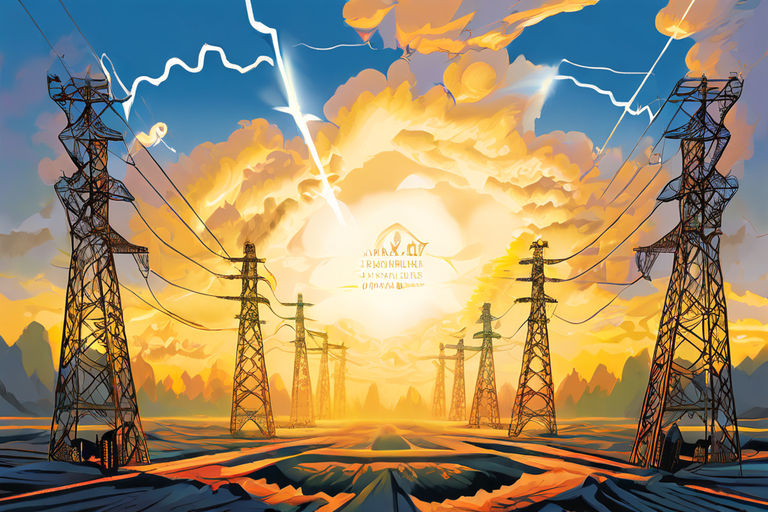Introduction
In the realm of physics, power stands as a fundamental concept, wielding significant influence across various scientific disciplines and everyday applications. Understanding its essence is crucial for comprehending the dynamics of energy transfer, mechanical systems, and technological advancements. In this comprehensive guide, we delve into the multifaceted definition of power in physics, unraveling its intricacies and real-world implications.
Defining Power in Physics
Power, in the context of physics, encapsulates the rate at which work is done or energy is transferred or converted. It serves as a measure of how quickly energy is transformed from one form to another or how rapidly work is accomplished. This fundamental quantity finds extensive utility in analyzing mechanical systems, electrical circuits, and thermodynamic processes.
Key Concepts
- Work: The exertion of force over a distance, resulting in the transfer of energy.
- Energy: The capacity to do work, existent in various forms such as kinetic, potential, and thermal energy.
- Rate of Change: Power signifies the speed at which energy is transferred or work is performed, emphasizing the temporal aspect of the process.
Types and Categories
Mechanical Power
Mechanical power refers to the work done or energy transferred by mechanical systems, such as engines, motors, and machines. It is quantified in units such as watts (W) or horsepower (hp), reflecting the rate at which these systems can perform tasks.
Internal Combustion Engines
Internal combustion engines serve as quintessential examples of mechanical power in action. These engines harness the chemical energy stored in fuel and convert it into mechanical work through controlled explosions within cylinders. The rapid expansion of gases resulting from combustion drives pistons, generating rotational motion that powers vehicles, machinery, and various industrial applications.
Electrical Power
Electrical power denotes the rate of energy transfer in electrical circuits, manifesting through the flow of electric charge. It is measured in watts and encompasses both the generation and consumption of electrical energy.
Ohm’s Law
Ohm’s Law, a fundamental principle in electrical engineering, elucidates the relationship between voltage (V), current (I), and resistance (R) in electrical circuits. This foundational law states that the current flowing through a conductor is directly proportional to the voltage applied across it and inversely proportional to the resistance of the conductor (I = V/R). Ohm’s Law provides a crucial framework for understanding and calculating electrical power in various circuit configurations.
Thermal Power
Thermal power represents the rate of heat transfer or conversion in thermodynamic processes. It plays a pivotal role in applications such as heat engines, refrigeration, and climate control systems.
Heat Engines
Heat engines utilize thermal power to convert heat energy into mechanical work, driving processes essential for transportation, electricity generation, and industrial operations. Whether in the form of steam turbines, gas turbines, or Stirling engines, heat engines leverage temperature differentials to produce useful work, powering everything from locomotives to power plants.
Symptoms and Signs
Understanding power in physics requires discerning its manifestations and effects within diverse phenomena. Symptoms and signs elucidate the observable outcomes of power-related processes, offering insights into their dynamics.
Acceleration
Acceleration serves as a tangible indication of power in mechanical systems, reflecting the rate of change in velocity over time. It correlates directly with the amount of force applied and the resulting increase in kinetic energy. In essence, the greater the power applied, the faster an object accelerates. This relationship is encapsulated by Newton’s second law of motion, which states that the acceleration of an object is directly proportional to the net force acting on it and inversely proportional to its mass.
Temperature Change
In thermal systems, power manifests through temperature changes, influencing the flow of heat and the equilibrium state of substances. Higher power inputs lead to more pronounced temperature variations, impacting the thermal behavior of materials. This phenomenon is governed by the principles of thermodynamics, which describe how energy is transferred as heat between systems. Whether through conduction, convection, or radiation, the transfer of heat power results in temperature changes within the system, affecting its overall thermal equilibrium and behavior.
Causes and Risk Factors
Exploring the origins of power in physics unveils the underlying mechanisms and determinants shaping its occurrence and magnitude. Causes and risk factors elucidate the factors driving power-related phenomena, ranging from fundamental principles to external influences.
Energy Sources
The availability and characteristics of energy sources profoundly influence power generation and utilization. Renewable sources such as solar, wind, and hydroelectric power offer sustainable alternatives to fossil fuels, mitigating environmental impacts and fostering energy independence. By harnessing the power of natural elements, societies can reduce reliance on finite resources and mitigate the adverse effects of carbon emissions, climate change, and resource depletion.
Efficiency and Losses
Efficiency considerations play a crucial role in power systems, governing the extent of energy conversion and utilization. Minimizing losses due to friction, resistance, and inefficiencies enhances overall system performance and resource utilization. Through advancements in technology, engineering, and operational practices, industries can optimize energy efficiency, reduce waste, and enhance the sustainability of power generation and utilization processes.
Diagnosis and Tests
Assessing and quantifying power in physics necessitates the application of analytical tools and experimental methodologies. Diagnosis and tests outline the procedures and techniques employed to measure and analyze power-related parameters accurately.
Instrumentation
Specialized instruments such as dynamometers, wattmeters, and calorimeters facilitate the direct measurement of power in mechanical, electrical, and thermal systems. These devices offer precise readings of power outputs and inputs, enabling comprehensive system characterization. Dynamometers assess mechanical power by measuring torque and rotational speed, while wattmeters quantify electrical power by monitoring voltage and current. Calorimeters, on the other hand, quantify thermal power by measuring heat transfer rates and temperature differentials. Together, these instruments provide invaluable insights into power generation, consumption, and transfer across diverse systems and applications.
Computational Modeling
Computational simulations and modeling techniques provide valuable insights into power dynamics, allowing for predictive analysis and optimization of system performance. Finite element analysis (FEA) and computational fluid dynamics (CFD) enable virtual experimentation and parametric studies, guiding design decisions and performance enhancements. By simulating complex phenomena such as fluid flow, heat transfer, and structural mechanics, computational models elucidate the intricate interactions and dependencies influencing power-related processes. This computational approach empowers engineers and scientists to explore a wide range of scenarios, optimize system designs, and mitigate potential risks before implementing real-world solutions.

Treatment Options
Addressing power-related challenges and optimizing performance necessitates the implementation of targeted interventions and corrective measures. Treatment options encompass a range of strategies aimed at enhancing efficiency, reliability, and sustainability across various domains.
Performance Optimization
Fine-tuning system parameters and operating conditions can significantly enhance power generation and utilization efficiency. Optimization techniques such as load balancing, gear ratio adjustments, and voltage regulation optimize resource allocation and minimize wastage. By precisely adjusting factors such as speed, torque, and energy input, organizations can maximize the output of their power systems while minimizing energy losses and operational costs. This proactive approach to performance optimization ensures that power resources are utilized efficiently and sustainably, supporting long-term viability and competitiveness.
Retrofitting and Upgrades
Incorporating advanced technologies and components through retrofitting and upgrades revitalizes existing power systems, extending their lifespan and improving performance. Upgrading to energy-efficient motors, controllers, and sensors enhances overall system reliability and responsiveness. By replacing outdated components with modern, more efficient alternatives, organizations can unlock significant gains in energy savings, productivity, and environmental sustainability. Retrofitting and upgrades also offer opportunities to integrate smart technologies and predictive maintenance solutions, further enhancing the resilience and efficiency of power infrastructure.
Preventive Measures
Proactive measures are essential for mitigating power-related risks and ensuring the long-term sustainability and resilience of systems. Preventive measures encompass a spectrum of strategies aimed at preemptively addressing potential issues and optimizing system performance.
Predictive Maintenance
Implementing predictive maintenance protocols leverages data analytics and condition monitoring techniques to anticipate and prevent equipment failures. Continuous monitoring of key parameters enables early detection of anomalies and proactive intervention, minimizing downtime and optimizing asset utilization. By analyzing trends and patterns in equipment behavior, organizations can identify potential failure points and schedule maintenance activities proactively, thereby avoiding costly disruptions and maximizing the lifespan of critical assets.
Training and Education
Investing in workforce training and education fosters a culture of safety, efficiency, and innovation within power-related industries. Comprehensive training programs equip personnel with the knowledge and skills necessary to operate, maintain, and troubleshoot complex power systems effectively. By empowering employees with up-to-date training on equipment operation, safety protocols, and best practices, organizations can enhance overall operational efficiency, reduce the risk of accidents and errors, and promote a culture of continuous improvement and innovation. Moreover, ongoing education ensures that personnel stay abreast of emerging technologies and industry trends, enabling them to adapt to changing circumstances and drive organizational success.
Personal Stories or Case Studies
Real-life experiences and case studies offer poignant insights into the tangible impacts and implications of power-related phenomena. Personal stories illuminate the human dimension of power, showcasing its role in shaping livelihoods, communities, and environments.
Empowering Communities
The advent of decentralized energy solutions has empowered communities worldwide, enabling access to reliable electricity and catalyzing socio-economic development. Off-grid solar installations, micro-hydro schemes, and community-owned wind farms exemplify grassroots initiatives driving positive change. In rural areas where conventional grid infrastructure is absent or unreliable, off-grid solar solutions provide households and businesses with access to clean, affordable energy, powering lights, appliances, and small-scale enterprises. Similarly, micro-hydro projects harness the power of local water resources to generate electricity, empowering remote communities and reducing dependence on fossil fuels. Community-owned wind farms represent a collective effort to harness renewable energy sources, providing not only clean power but also economic opportunities and community resilience. These initiatives demonstrate the transformative potential of decentralized energy systems in improving livelihoods, enhancing resilience, and fostering inclusive development.
Technological Innovations
Breakthroughs in power technology have revolutionized industries and transformed societal norms, heralding a new era of connectivity and progress. From electrification initiatives in rural areas to smart grid deployments in urban centers, innovation continues to expand the frontiers of possibility. In rural communities lacking access to centralized grid infrastructure, innovative solutions such as solar-powered mini-grids and pay-as-you-go solar systems are transforming lives, providing clean energy access for lighting, cooking, and productive use. Meanwhile, in urban environments, smart grid technologies are revolutionizing energy distribution and management, enabling real-time monitoring, demand response, and optimization of electricity networks. These technological innovations not only enhance energy efficiency and reliability but also pave the way for sustainable development, climate mitigation, and inclusive growth. As society embraces these advancements, the potential for positive impact on individuals, communities, and the planet is boundless.
Expert Insights
Gaining perspectives from domain experts and thought leaders enriches our understanding of power in physics, offering nuanced interpretations and practical recommendations. Expert insights provide valuable context and guidance for navigating complex challenges and opportunities.
Dr. Sarah Chang, Ph.D.
“As a leading researcher in renewable energy systems, I’ve witnessed the transformative potential of sustainable power solutions firsthand. By harnessing the forces of nature responsibly, we can pave the way for a cleaner, greener future.”
Prof. Michael Rodriguez, Electrical Engineering
“Electrical power systems form the backbone of modern civilization, enabling communication, transportation, and commerce on a global scale. Embracing digitalization and renewable energy integration holds the key to unlocking a more resilient and sustainable energy landscape.”
These expert perspectives underscore the critical role of innovation, sustainability, and collaboration in shaping the future of power generation, distribution, and utilization. By heeding their insights, we can navigate the complexities of power-related challenges and chart a course towards a more sustainable and equitable energy future.
Conclusion
In conclusion, power in physics embodies the essence of energy transformation and execution, permeating every facet of our existence, from the mechanics of motion to the intricacies of technological innovation. By grasping its intricacies and harnessing its potential, we can forge a path towards a more sustainable and prosperous future.
Through a comprehensive exploration of its definitions, types, manifestations, and applications, we’ve gained a deeper understanding of the multifaceted nature of power. From mechanical and electrical systems to thermal processes and beyond, power serves as a fundamental driver of change and progress in our world.
By recognizing the importance of efficiency, sustainability, and innovation, we can leverage the power of physics to address global challenges, enhance quality of life, and safeguard the environment for future generations. Whether through renewable energy solutions, advanced technologies, or community empowerment initiatives, the pursuit of power holds immense potential for positive impact and transformative change.
As we continue to unravel the mysteries of power and unlock its potential, let us remain committed to harnessing this fundamental force for the greater good, driving progress, prosperity, and sustainability for all.


